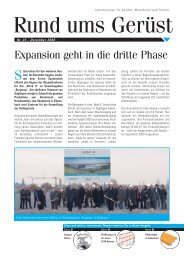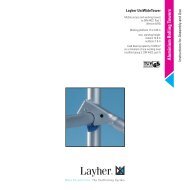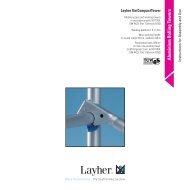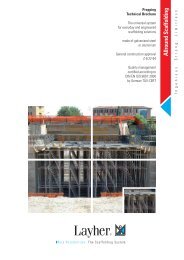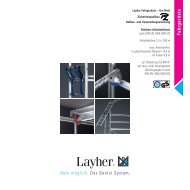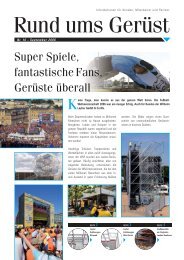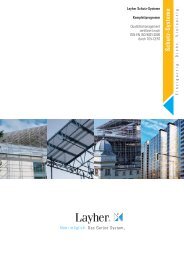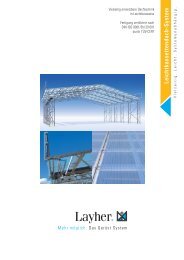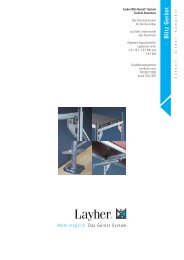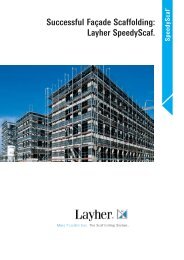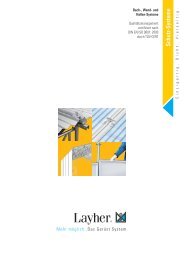AuV - Uni Standard P2 - Layher
AuV - Uni Standard P2 - Layher
AuV - Uni Standard P2 - Layher
You also want an ePaper? Increase the reach of your titles
YUMPU automatically turns print PDFs into web optimized ePapers that Google loves.
} 1. INTRODUCTION<br />
General<br />
These instructions for assembly and use relate to the assembly,<br />
modification and dismantling of the <strong>Layher</strong> <strong>Uni</strong> <strong>Standard</strong> rolling tower<br />
from Wilhelm <strong>Layher</strong> GmbH & Co. KG, of Gueglingen-Eibensbach,<br />
Germany. These instructions cannot cover all possible applications.<br />
If you have any questions about specific applications, please contact<br />
your <strong>Layher</strong> partner.<br />
Caution: <strong>Layher</strong> <strong>Uni</strong> <strong>Standard</strong> equipment may only be assembled,<br />
modified and dismantled under the supervision of a qualified expert<br />
and by technically trained employees.<br />
} 2. GENERAL DIRECTIONS<br />
FOR ASSEMBLY AND USE<br />
The rolling tower may be used for the scaffolding group as specified<br />
in DIN EN 1004.<br />
The user of the rolling tower must comply with the following<br />
instructions:<br />
1. The user must check the suitability of the selected rolling tower for<br />
the work to be performed (Section 4 of BetrSichV – German Ordinance<br />
on Industrial Safety and Health).<br />
2. According to DIN EN 1004:2005-03 the maximum platform height is<br />
• 12.0 m when inside buildings<br />
• 8.0 m when outside buildings<br />
The specifications governing ballasting and components on pages<br />
8 – 10 and 18 – 19 must be observed. There is a risk of accident if this<br />
is not done. Stability and load-bearing capacity are no longer assured.<br />
Any variations in assembly that differ from the specifications may<br />
require additional design measures. In such a case, the stability and<br />
load-bearing capacity would have to be verified for the individual case.<br />
3. The assembly, modification or dismantling of the rolling tower in<br />
accordance with the present instructions for assembly and use may<br />
only be performed under the supervision of a qualified expert and<br />
by technically trained employees after special instruction. Only the<br />
4<br />
scaffolding types shown in these instructions for assembly and use<br />
may be used. After assembly and before being put into service, the<br />
equipment must be inspected by persons qualified to do so (Sections<br />
4 and 10 of BetrSichV). The inspection must be documented (Section<br />
11 of BetrSichV). During assembly, modification or dismantling, the<br />
rolling tower must be provided with a prohibition sign indicating “No<br />
access allowed” and be adequately safeguarded by means of barriers<br />
preventing access to the danger zone (BetrSichV Annex 2, para. 5.2.5).<br />
4. Before installation, all parts must be inspected to ensure they are in<br />
perfect condition. Only undamaged original parts from <strong>Layher</strong>‘s mobile<br />
working platform systems may be used. Scaffolding parts such as snapon<br />
claws and spigots must be cleaned of dirt after use. Scaffolding<br />
components must be secured against slipping and impacts when transported<br />
by truck. Scaffolding components must be handled in such a way<br />
that they are not damaged. See the tables on pages 8 – 10 of these<br />
instructions for wall bracing and attachment of the ballast weights.<br />
5. In order to assemble the upper sections of the rolling tower, the<br />
individual parts must be handed up from one level to the next. Tools<br />
and small amounts of materials can be carried up by the personnel,<br />
otherwise hoisted up to the working level using transport ropes.<br />
6. The ladder frame joints must always be secured with locking pins.<br />
7. Suitable materials must be inserted underneath to ensure that<br />
the scaffolding is perpendicular. The permitted deviation from the<br />
perpendicular must not be more than 1 %.<br />
8. Stability must be ensured at every phase of assembly.<br />
9. Toe boards can be omitted from intermediate platforms that are only<br />
used for ascent. Small towers in which the deck surface is more than<br />
1.00 m high must include equipment that permits attachment of side<br />
protection in accordance with DIN EN 1004:2005-03.<br />
10. Access up to the working platform is generally only permitted on the<br />
inside of the scaffolding. Scaffolding types with an assembly height of<br />
less than 1 m are an exception to this rule.<br />
11. Work must not take place on two or more working levels at the same<br />
time. The manufacturer must be consulted regarding any variations. If<br />
work is to take place on more than one level, they must be fully fitted<br />
with 3-piece side protection.




